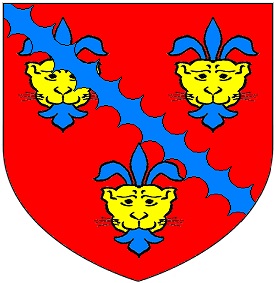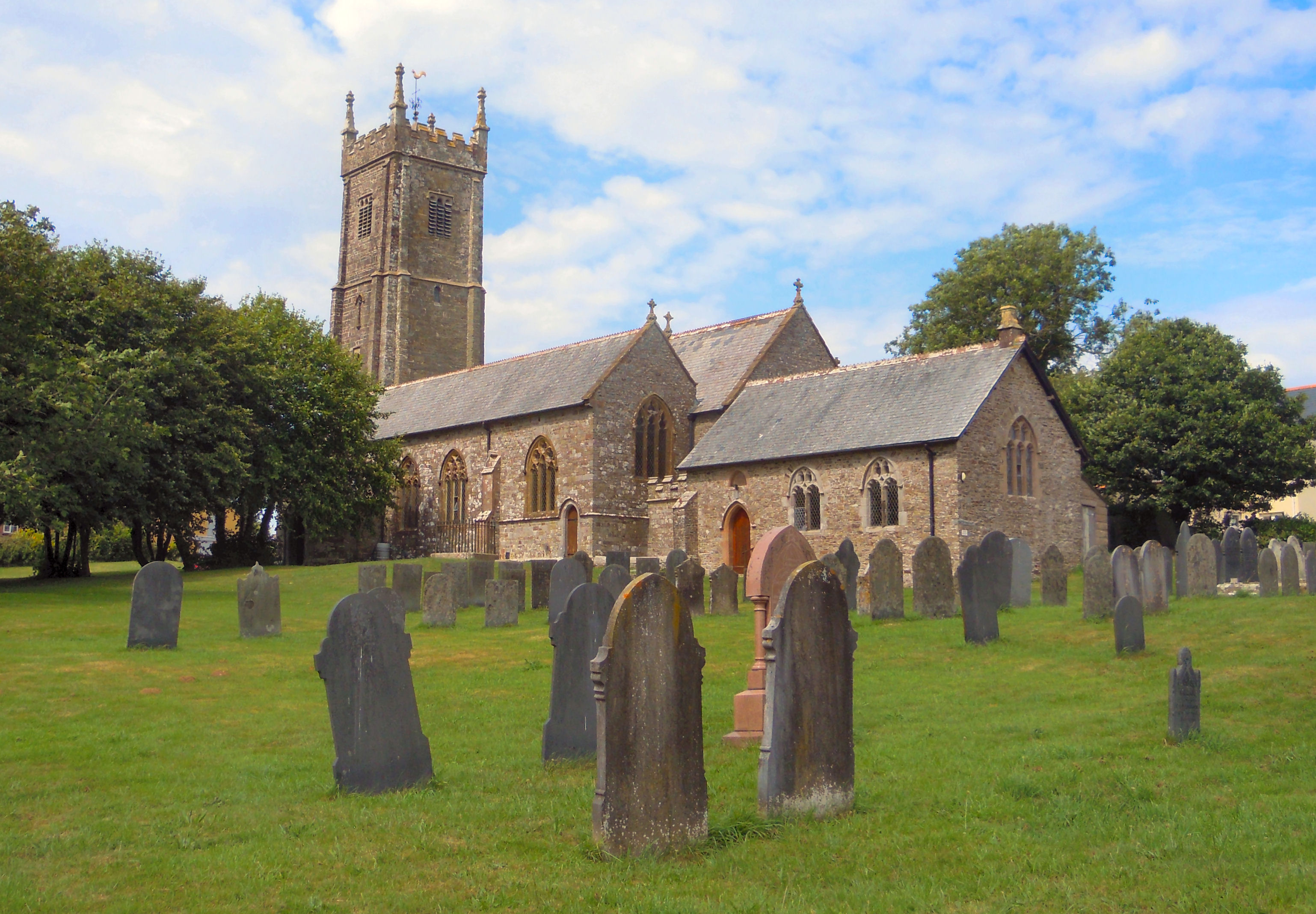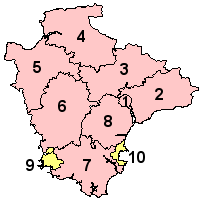|
Orleigh
Orleigh Court is a late medieval manor house in the parish of Buckland Brewer about 4 miles (6.4 km) south-west of Bideford, North Devon, England. It is a two-storeyed building constructed from local slate stone and has a great hall with a hammer-beam roof, installed in the late 15th century. The building was substantially altered in the early 18th century and remodelled after 1869. It was redeveloped for multiple occupancy in the 1980s and is now divided into about twelve apartments. It was the birthplace of the famous explorer and discoverer of the source of the River Nile, John Hanning Speke (1827–1864). History Early The earliest parts of the building to survive were built by a member of the Denys family. The hall, which is 30 ft x 20 ft and has 5-foot-thick walls, has been dated by the form of decoration around the doorways to the early to mid-14th century.Emery (2006), pp. 611–12 In 1416, a licence for a chapel at the house was granted by Bishop Stafford, and ... [...More Info...] [...Related Items...] OR: [Wikipedia] [Google] [Baidu] |
Denys Family
The surname Denys was borne by at least three prominent mediaeval families seated in Gloucestershire, Somerset and Devon in southwest England between 1166 and 1641. It is not known if any relationship existed between these families. The surname ''Denys'' is just one of many variant spellings of the name: ''Denise'', ''Le Deneis'', ''Le Danies'', ''le Deneys'' ,and most recently ''Dennis'', are some of the others. The family of Denys was apparently of Danish origin, and was recorded in early Norman charters in French as ''le Deneys'', meaning "The Dane", which was frequently Latinised by scribes as Dacus, being the adjectival form of ''Dacia'', the mediaeval Latin for Denmark, thus "Danish". Denys of Gloucestershire An early and influential west-country family named Denys seems to have originated in Gloucestershire in the 13th century and to have moved into Glamorgan, where it was resident at Waterton, before moving back to Gloucestershire c. 1380, where it was seated at Siston ... [...More Info...] [...Related Items...] OR: [Wikipedia] [Google] [Baidu] |
John Davie
John Davie (1640–1710) of Orleigh Court in the parish of Buckland Brewer, Devon, England, was a prominent tobacco merchant from Bideford, Devon. His Bideford town house which he built in 1688, was ''Colonial House'', now the Royal Hotel, in which survive several 17th-century decorative plasterwork ceilings, said by Pevsner & Cherry (2004) to be amongst the best in Devon, and a grand staircase. Origins John Davie was the son of John Davie by his wife Marie Sutton who were married in 1638. The Devon topographer Rev. John Swete wrote in 1797 of the family's origin: "The family of Davie is supposed to have assumed its appellation from ''de Via'', or ''de Way'', their antient seat in or near the parish of Harwood ''(possibly Horwood, 3 miles east)'' three miles south east of Biddeford. The place also where this name long flourished was Uppecott in the parish of Beauford near Great Torrington which hereditarily descended unto it from Gilbert (surnamed thereof) who owned it in ... [...More Info...] [...Related Items...] OR: [Wikipedia] [Google] [Baidu] |
Church Of St Mary And St Benedict
St Mary and St Benedict is the Church of England parish church for the village of Buckland Brewer near Bideford in North Devon. It is part of the benefice of the Hartland Coast Team Ministry. This falls within Hartland Deanery, in the Archdeaconry of Barnstaple in the Diocese of Exeter. Begun in the 14th-century with 15th-century additions and retaining several architectural features from the first church of about 1100, the building was much restored in the 19th-century and has been a Grade II* listed building on the Register of Historic England since 1958.Church of St Mary and St Benedict at Buckland Brewer - |
John Lee Lee
John Lee Lee (11 December 1802 – 16 August 1874) of Orleigh Court in the parish of Buckland Brewer in Devon, and of Dillington House, near Ilminster in Somerset, was a British Whig politician who was Member of Parliament for Wells in Somerset between 1830 and 1837. He was Sheriff of Somerset in 1845–6. He was born "John Lee Hanning", the only son and heir of William Hanning (died 1834) of Dillington House, near Ilminster in Somerset by his wife Harriett Lee, daughter of Edward Lee of Pinhoe, Devon. In 1819 at the age of 17, by the will of his uncle Major Edward Lee (d.17 January 1819) of Orleigh, he inherited several estates including Orleigh. Under the terms of the bequest he adopted the surname Lee by royal licence dated 21 March 1825. He let Orleigh to his brother-in-law William Speke of Jordans near Ilminster (father of the River Nile explorer John Hanning Speke (1827–1864))Rogers, p.58 and made his own residence at Dillington. In 1830 he was elected one of the Members ... [...More Info...] [...Related Items...] OR: [Wikipedia] [Google] [Baidu] |
Buckland Brewer
Buckland Brewer is a village and civil parish in the Torridge district of Devon, England, 4.7 miles south of Bideford. Historically the parish formed part of Shebbear Hundred. According to the 2001 census it had a population of 777, increasing to 794 at the 2011 census The village is part of Waldon electoral ward. The population for this at the same census was 1,679. __TOC__ Population Historical population figures show a variable trend of increased and decreased population. Torridge District Council historical data shows the following populations: * 1801: 872 * 1901: 644 * 2001: 777 Religion The parish church of St Mary and St Benedict (Church of England) is part of the benefice of the Hartland Coast Team Ministry. This falls within Hartland Deanery, in the Archdeaconry of Barnstaple. This is in the Diocese of Exeter. The church tower is over 500 years old, with a Norman stoup and doorway. There are monuments to, among others, John William Taylor of John Taylor & Co, th ... [...More Info...] [...Related Items...] OR: [Wikipedia] [Google] [Baidu] |
Watermouth Castle
Watermouth Castle is a building in Watermouth, near Ilfracombe, North Devon, England, designed by George Wightwick as a residence for the Bassett family in the mid-19th century and is not a true castle but a country house built to resemble one. It has been designated as a Grade II* listed building. Located near the shore of the inlet of Watermouth, near Ilfracombe, Devon, the castle houses a collection of Victorian antiques centred on domestic tools and amusement machines, a family theme park and holiday apartments. The Bassetts left the castle in 1945. Descent of ownership Bassett The castle was built by Joseph Davie Bassett (1764–1846), son of John Davie (died 1793) of Orleigh Court, Buckland Brewer and his wife Eleanora Basset of Heanton Court, Heanton Punchardon. His brother was Rev. Charles Davie (1760–1836), rector of Heanton Punchardon, which advowson was possessed by the Bassett family. After his mother became the sole heiress of her childless brother Francis Basse ... [...More Info...] [...Related Items...] OR: [Wikipedia] [Google] [Baidu] |
Weare Giffard
Weare Giffard is a small village, civil parish and former manor in the Torridge district, in north Devon. The church and manor house are situated 2 1/2 miles NW of Great Torrington in Devon. Most of the houses within the parish are situated some 1/2-mile east of the church. The church is situated on a hillside to the north and slightly above the wide and flat valley floor of the River Torridge. The Church of the Holy Trinity and the adjacent Weare Giffard Hall are designated members of the Grade I listed buildings in Devon. History The historian of Devon Tristram Risdon (d.1640) supposed the name Weare to be derived from a fish weir which was historically situated in the river to catch fish. The construction of a fish-weir generally required a licence from the feudal overlord, as naturally these affected the catches of other inhabitants further along the river. Many disputes are recorded in the medieval records over disputes concerning fish-weirs. Descent of the manor Giffar ... [...More Info...] [...Related Items...] OR: [Wikipedia] [Google] [Baidu] |
John Hanning Speke
Captain John Hanning Speke (4 May 1827 – 15 September 1864) was an English explorer and officer in the Indian Army (1895–1947), British Indian Army who made three exploratory expeditions to Africa. He is most associated with the search for the Nile#The search for the source of the Nile, source of the Nile and was the first European to reach Lake Victoria (known to locals as ''Nam Lolwe'' in Dholuo and ''Nnalubaale'' or ''Ukerewe'' in Luganda). Speke is also known for propounding the Hamitic#Hamitic hypothesis, Hamitic hypothesis in 1863, in which he supposed that the Tutsi ethnic group were descendants of the biblical figure Ham (son of Noah), Ham, and had lighter skin and more Hamitic features than the Bantu Hutu over whom they ruled. Life Speke was born on 4 May 1827 at Orleigh Court, Buckland Brewer, near Bideford, North Devon. In 1844 he was commissioned into the British Army and posted to British India, where he served in the 46th Bengal Native Infantry under Sir ... [...More Info...] [...Related Items...] OR: [Wikipedia] [Google] [Baidu] |
Slate
Slate is a fine-grained, foliated, homogeneous metamorphic rock derived from an original shale-type sedimentary rock composed of clay or volcanic ash through low-grade regional metamorphism. It is the finest grained foliated metamorphic rock. Foliation may not correspond to the original sedimentary layering, but instead is in planes perpendicular to the direction of metamorphic compression. The foliation in slate is called "slaty cleavage". It is caused by strong compression causing fine grained clay flakes to regrow in planes perpendicular to the compression. When expertly "cut" by striking parallel to the foliation, with a specialized tool in the quarry, many slates will display a property called fissility, forming smooth flat sheets of stone which have long been used for roofing, floor tiles, and other purposes. Slate is frequently grey in color, especially when seen, en masse, covering roofs. However, slate occurs in a variety of colors even from a single locality; for ex ... [...More Info...] [...Related Items...] OR: [Wikipedia] [Google] [Baidu] |
Oriel Window
An oriel window is a form of bay window which protrudes from the main wall of a building but does not reach to the ground. Supported by corbels, bracket (architecture), brackets, or similar cantilevers, an oriel window is most commonly found projecting from an upper floor but is also sometimes used on the ground floor. Oriel windows are seen in Arab architecture in the form of mashrabiya and in Turkish are known as ''şahnişin'' or ''cumba''. In Islamic culture, these windows and balconies project from the street-front of a house, providing an area in which women could peer out and see the activities below while remaining invisible. Origins According to the ''Oxford English Dictionary'', the term ''oriel'' is derived from Anglo-Norman language, Anglo-Norman ' and Late Latin ', both meaning "gallery" or "porch", perhaps from Classical Latin ' ("curtain"). * Oriel College, Oxford, took its name from a balcony or oriel window forming a feature of a building which occupied the ... [...More Info...] [...Related Items...] OR: [Wikipedia] [Google] [Baidu] |
Grade I Listed Buildings In Devon
The county of Devon is divided into ten districts. The districts of Devon are Exeter, East Devon, Mid Devon, North Devon, Torridge, West Devon, South Hams, Teignbridge and the unitary authorities Plymouth and Torbay. As there are 427 Grade I listed buildings in the county they have been split into separate lists for each district. * Grade I listed buildings in East Devon * Grade I listed buildings in Exeter * Grade I listed buildings in Mid Devon * Grade I listed buildings in North Devon * Grade I listed buildings in Plymouth * Grade I listed buildings in South Hams * Grade I listed buildings in Teignbridge * Grade I listed buildings in Torbay * Grade I listed buildings in Torridge * Grade I listed buildings in West Devon See also * Grade II* listed buildings in Devon Grade II* listed buildings in Devon are listed buildings in the county of Devon, England, that are particularly important buildings of more than special interest. The county of Devon is divided into ten dis ... [...More Info...] [...Related Items...] OR: [Wikipedia] [Google] [Baidu] |
Medieval Architecture
Medieval architecture is architecture common in the Middle Ages, and includes religious, civil, and military buildings. Styles include pre-Romanesque, Romanesque, and Gothic. While most of the surviving medieval architecture is to be seen in churches and castles, examples of civic and domestic architecture can be found throughout Europe, in manor houses, town halls, almshouses, bridges, and residential houses. Designs Religious architecture The Latin cross plan, common in medieval ecclesiastical architecture, takes the Roman basilica as its primary model with subsequent developments. It consists of a nave, transepts, and the altar stands at the east end (see '' Cathedral diagram''). Also, cathedrals influenced or commissioned by Justinian employed the Byzantine style of domes and a Greek cross (resembling a plus sign), with the altar located in the sanctuary on the east side of the church. Military architecture Surviving examples of medieval secular architecture mainly s ... [...More Info...] [...Related Items...] OR: [Wikipedia] [Google] [Baidu] |






